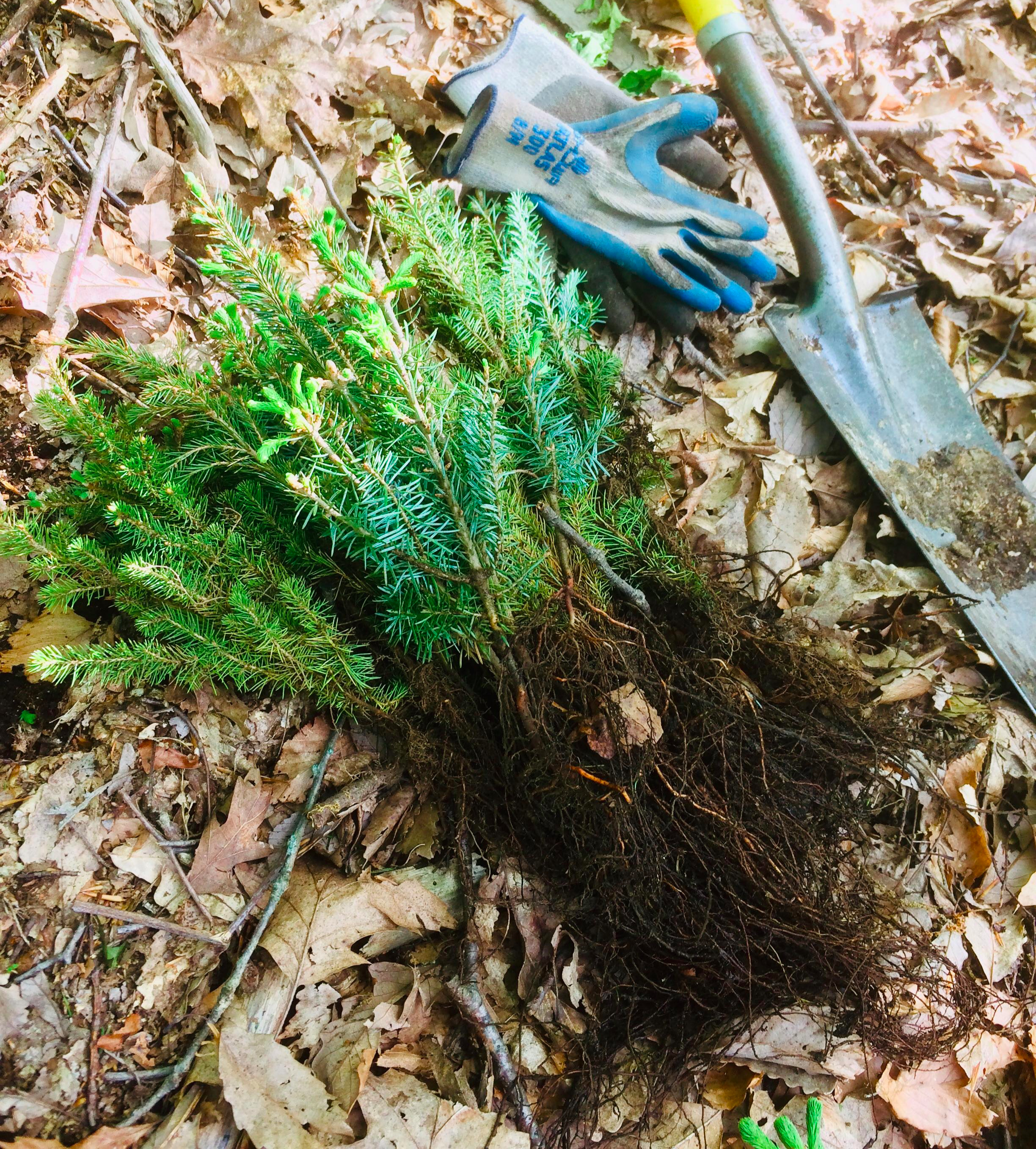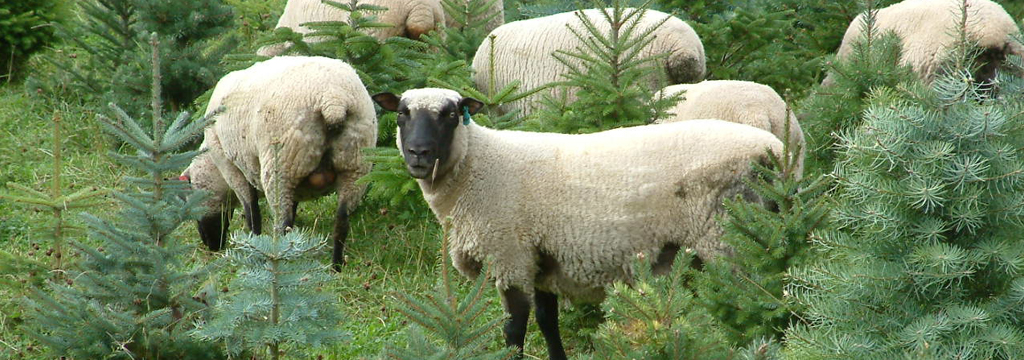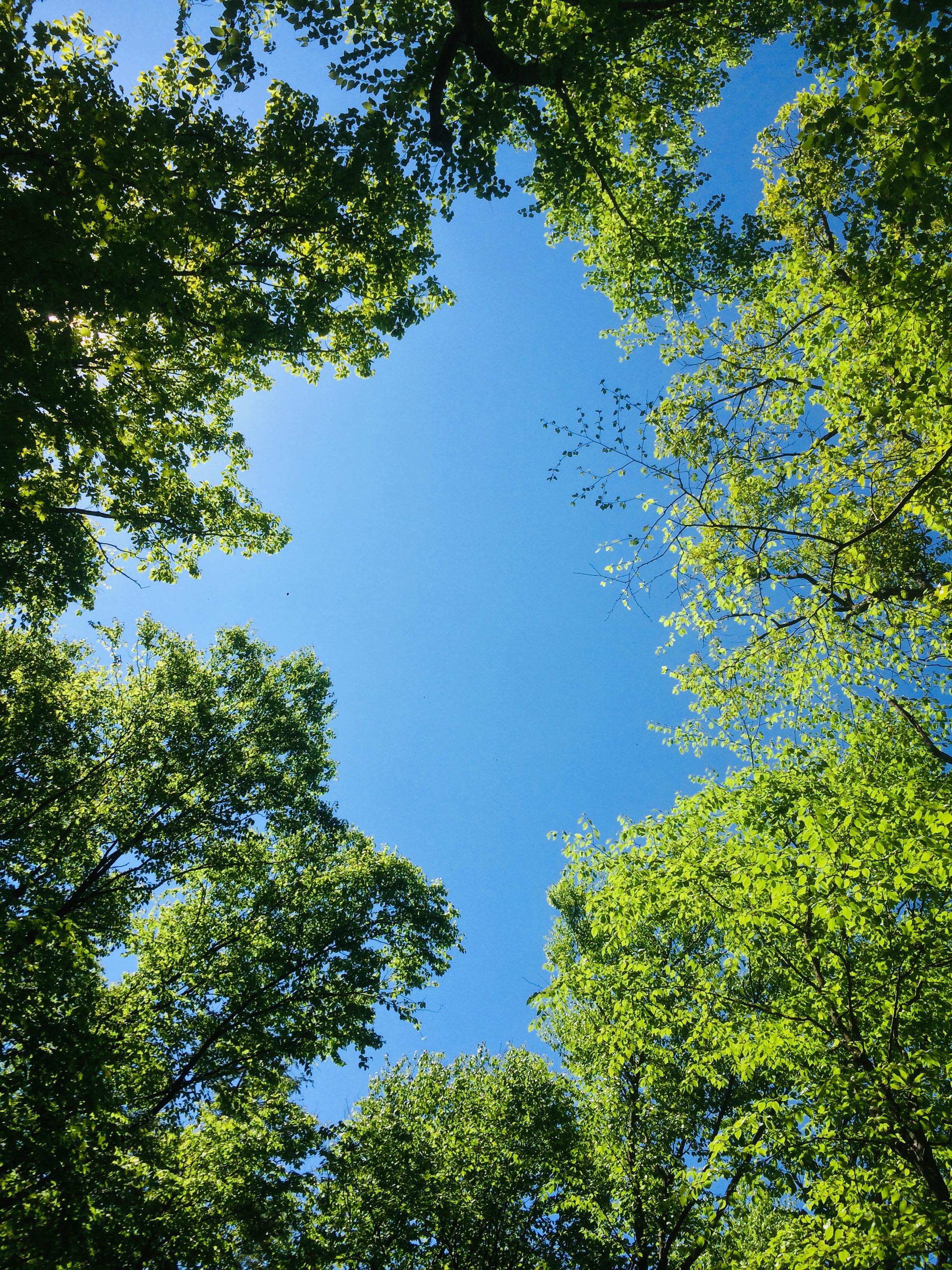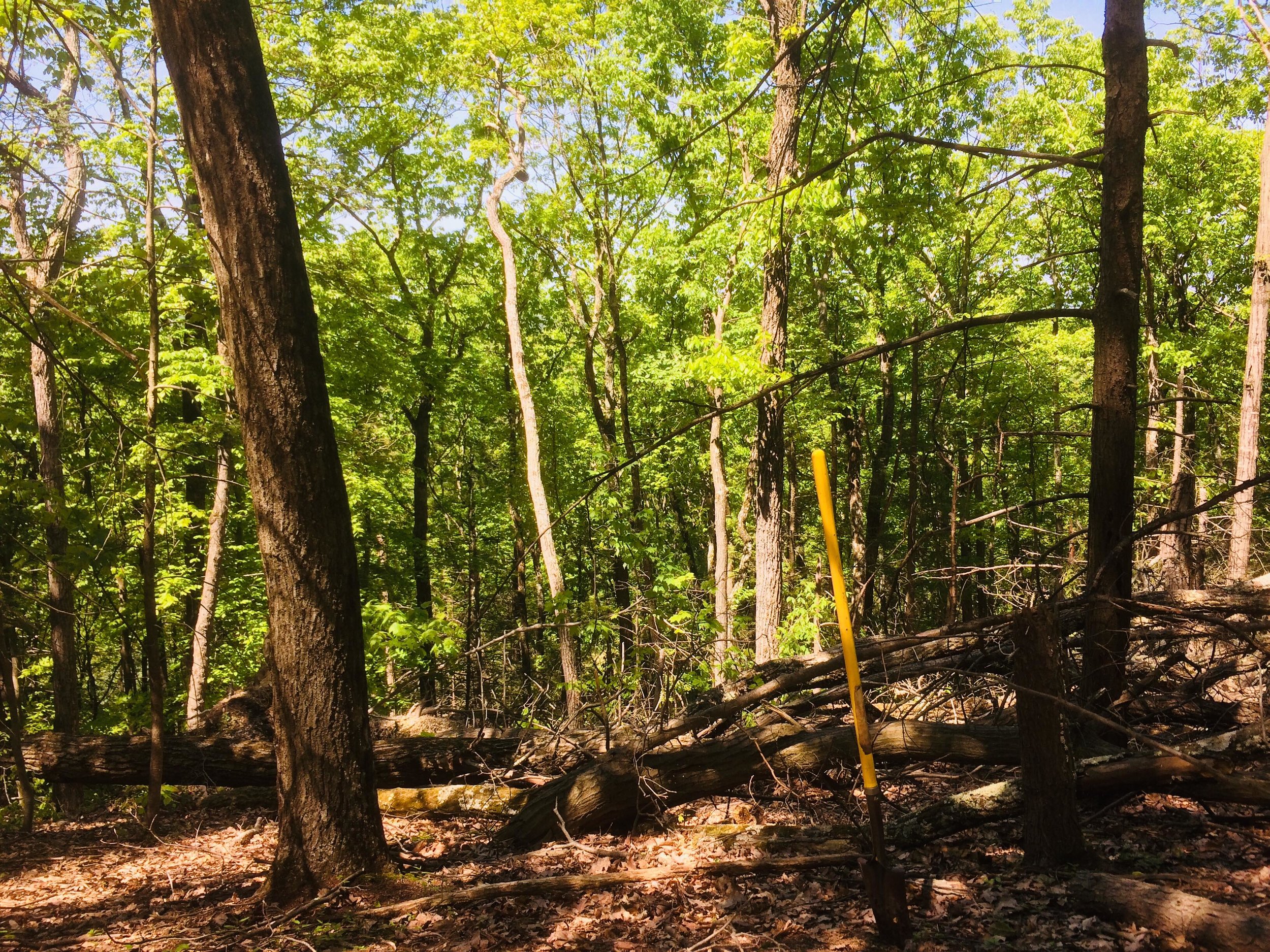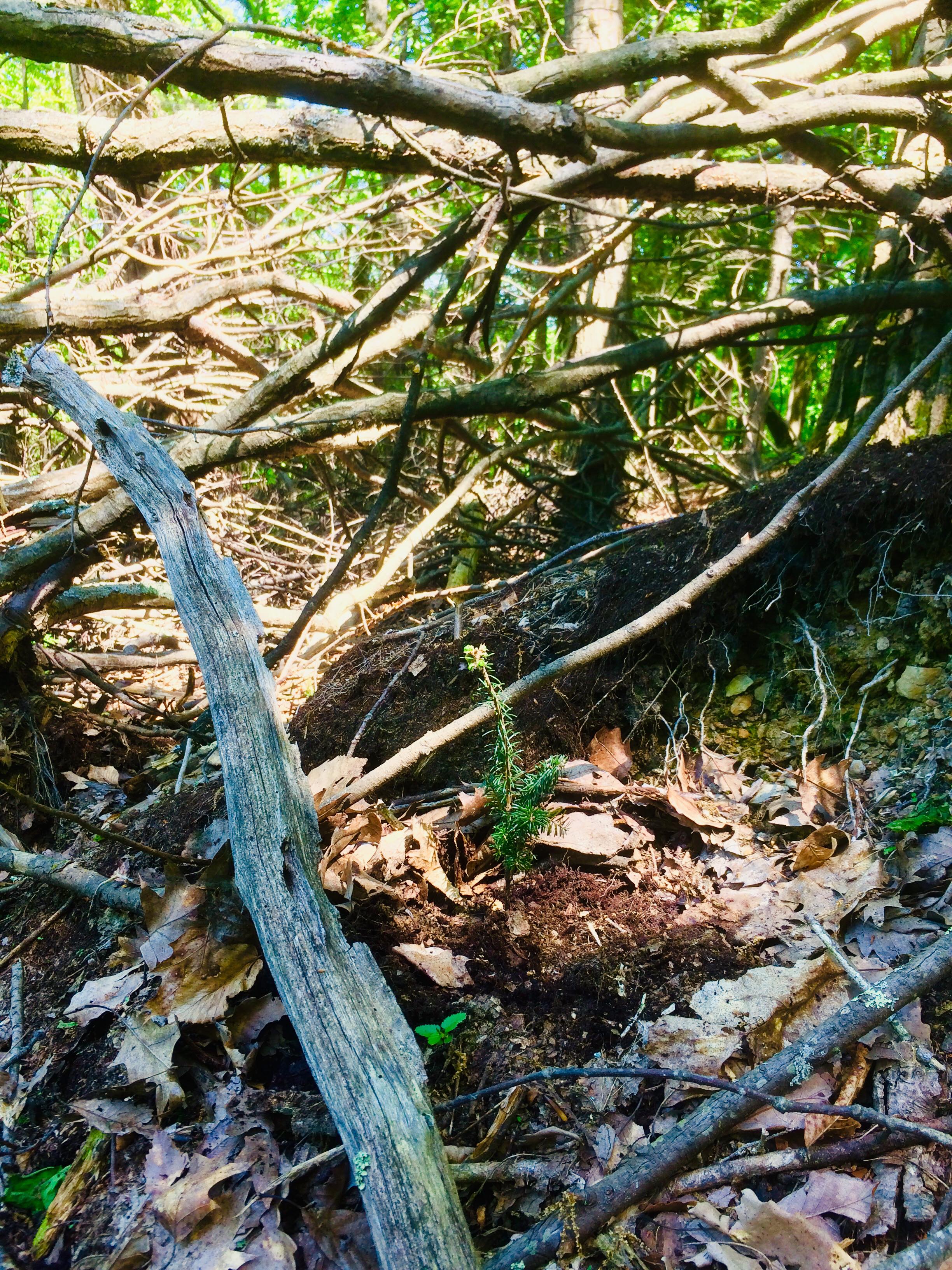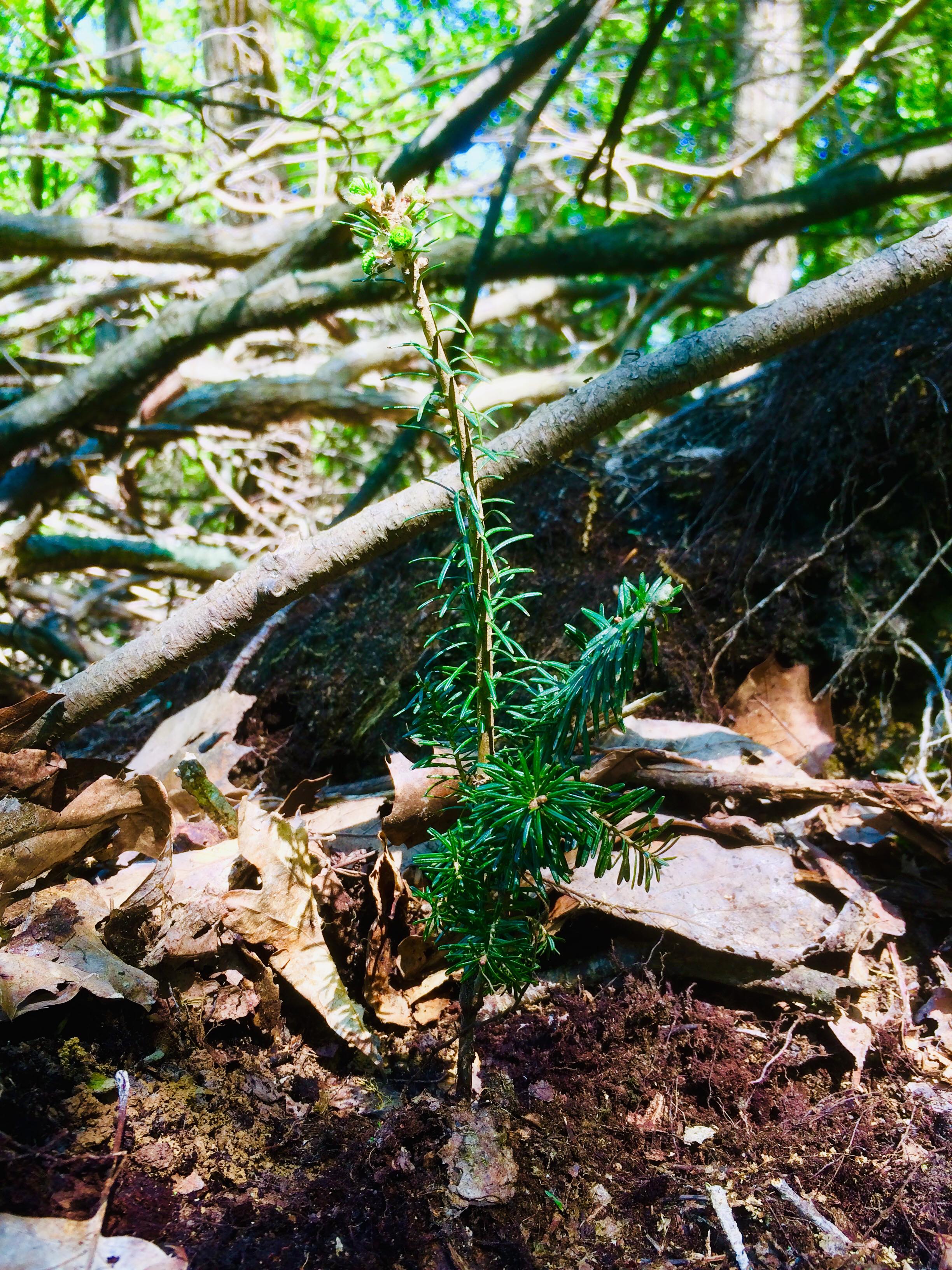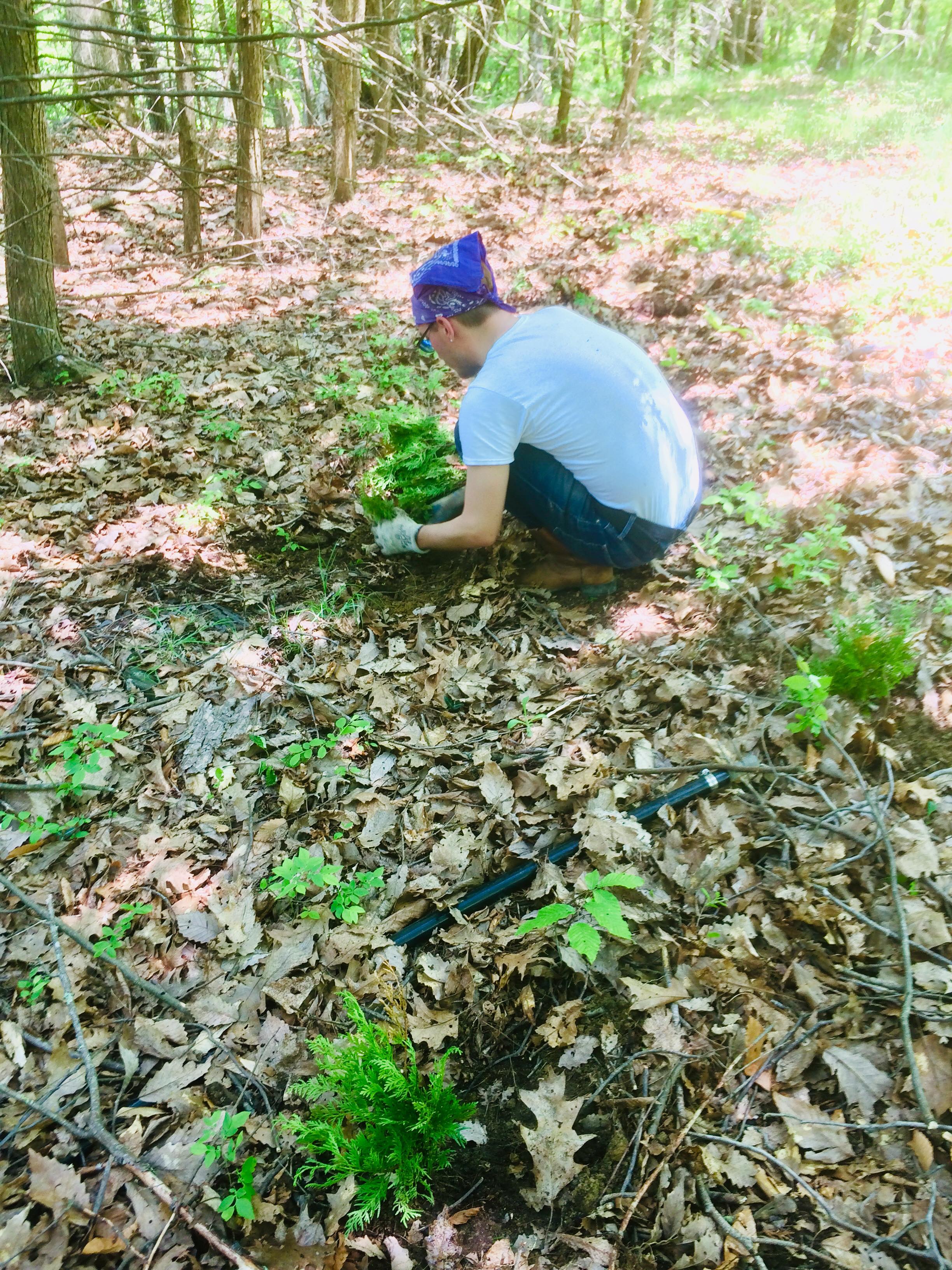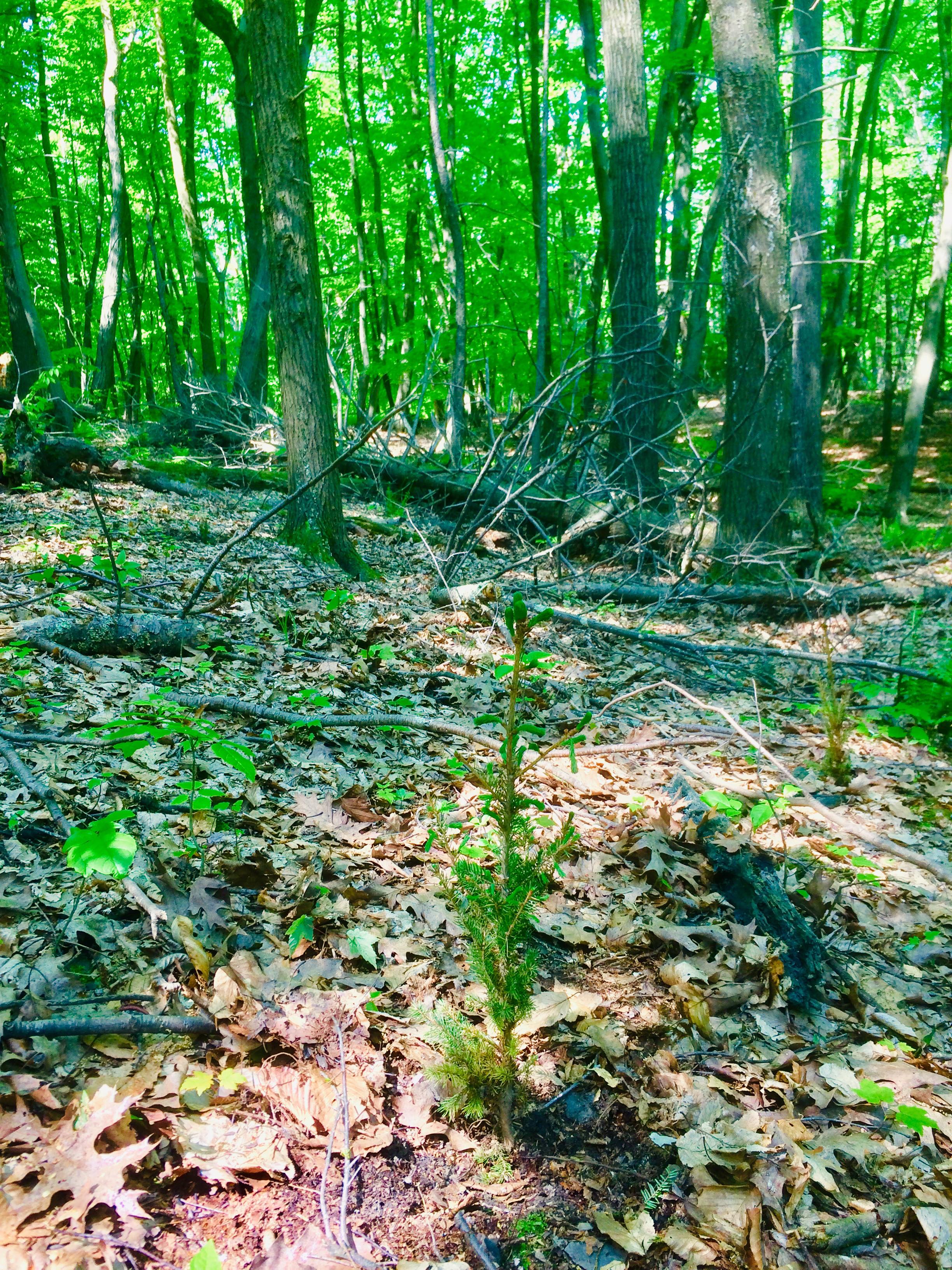Christmas Tree Farms & Climate Change: A Permaculture Perspective
Some farms are blessed with good soils, terrain, and water. Others, like ours, are not so lucky. On our already infertile and rocky farm, there is one area in particular that has long been a challenge for us. It is the steepest hillside on our property, inaccessible except by foot up switchback trails, with thin eroding soils and a canopy dominated by dying hemlocks and windbent chestnut oaks. It is, in short, a most unideal site for most agriculture, and so we have left it alone - until this year.
A bundle of Fraser fir, Canaan fir, and red spruce await planting on our steep hill.
We recently came across an article that detailed a very unusual method for managing conifers on a Christmas tree farm. Called “stump culture” or “coppicing,” this method can grow multiple Christmas trees simultaneously from a single stump. Coppicing involves cutting a tree back to or near the ground, and allowing it to resprout many trunks - a method that is perhaps the oldest means of managing woodland, with evidence of its use as far back as the Neolithic. Although it has traditionally been used on deciduous trees like willow or chestnut, an almost unknown history exists of coppicing evergreens around the world - and some are rediscovering these methods to put toward new uses.
One farm in Western Massachusetts is reviving the ancient art of coppicing, using native conifers. Photo source.
In the 1940s, Christmas tree growers in the U.S. and Canada discovered that by cutting off the top of a balsam fir (Abies balsamea) tree, leaving only the lowest skirt of horizontal branches, and letting those branches resprout, they could get 3 or 4 trees to grow from a single root system. These sprouted trees could be sequentially harvested and allowed to resprout, meaning that a single stump-cultured tree could produce harvestable Christmas trees every 4 or 5 years for decades, if not centuries (some coppiced evergreens in Japan are over 500 years old), without having to replant anything. This allows the root system to expand, making the tree more resistant to drought, disease, pests, and grow more rapidly every year to boot. It also allows the field itself to remain under tree cover, and not face constant stress, erosion, and depletion of nutrients through regular replanting of small trees. Over time, the stump-culture Christmas tree field becomes a highly biodiverse managed forest - a perennial agroecosystem that improves with time and can last indefinitely, producing high-quality Christmas trees every year without chemical sprays, heavy machinery, or much labor beyond light yearly pruning and scything of the weeds.
The stump culture balsam groves comprise a complex managed forest landscape that defy mechanization, or even straight rows. Photo source.
Emmet van Driesche of Pieropan Christmas Tree Farm in West Massachusetts is pioneering this method on the East Coast, having learned it from Al Pieropan (who sold the namesake farm to him). Emmet has published a book that details the many innovative ways his family makes a sustainable income while doing what they love on their farm. Stump culturing Christmas trees is a central part of this work, and the methods he uses are a beautiful example of how to create a good income in a managed forest farm with only hand tools.
Emmet manages his balsam groves with only hand tools, particularly three different scythes: one for grass, a medium one for smaller areas with small woody stems, and a “short stout one that I use to beat apart rose thickets and saplings the size of my thumb.” This kind of low-tech management is elegant in its simplicity and ancient in its tradition. Photo source.
These Christmas trees are offered to the public for $30 (any size), half of which are sold as “cut-your-own”, and the other half as pre-cut trees that are sold to local stores. The managed balsam groves that Emmet and his family manage produce around 500 trees to sell every year on 10 acres. Additional sources of income include wreaths made from fir boughs, spoons carved from wood harvested on the farm, and other crafts that create multiple streams of income throughout the year.
A freshly cut stump cultured balsam fir sprouts anew. The most vigorous and well-spaced sprouts will be allowed to grow, and the others pruned off. Photo source.
On a site like our hillside in eastern PA, with erosion of thin soils and high winds that take down tall trees, a native evergreen that can push deep roots into the hillside, stabilize the soil, and be maintained to stay short indefinitely (while also producing a regular marketable crop of Christmas trees) sounds to us like a winning combination. In addition to their use as Christmas trees, Balsam fir and its relatives can also be used to make Canada balsam (used as a cold remedy and a glue for glasses), and balsam fir oil (a non toxic rodent repellent), in addition to a number of other medicinal applications.
After a few years, the dominant sprout begins shaping into a marketable Christmas tree for harvesting. There are two or three other sprouts growing on the stump, waiting to become leaders when this one gets cut. Photo source.
What’s more, because the stump-culture trees let partial sun into the understory, these systems allow for high levels of biodiversity and greater potential for intercropping with other plants or livestock. In his book, Emmet van Driesche provides this description of his balsam fir groves: ”the skirts of branches on the stumps shade out much of the ground, although certainly not all, and the ground cover is a mix of mosses, ferns, huckleberry, dogwood, and willow. There are a few areas still covered with brambles...”
Biodiversity is at home in these types of managed forests, particularly when most of the trees are native. Photo source.
Many of these natural companions are marketable crops, and our site in PA is very similar in composition. We will be planting more blueberries, elderberries, aronia, and other shade-tolerant productive shrubs between our firs and spruces to supplement income and create a robust polyculture. Indeed, Emmet van Driesche is already doing this type of polycultural harvest at Pieropan, as mentioned in his book: ”this is a truly managed forest… some of the species have economic value - the winterberry I use to decorate wreaths, the willow I plan to wholesale to basket makers, the trees I harvest to carve into spoons, and the saplings I cut to make scythe handles.”
Stump culture Christmas tree farms were in fact the first agroforestry systems implemented in British Columbia, where livestock graze on the native grasses growing beneath the trees (and left the trees alone!). It’s not hard to imagine poultry or sheep being run through this kind of system as well. Additionally, stump culture tree farms in British Columbia also utilize the groundcover layer to grow native understory plants that command high prices in the floral trade. Using these kinds of farms for silvopasture is gaining popularity on the West Coast, and even has precedent east of the Mississippi.
Sheep, cattle, and other livestock can all be seamlessly integrated into Christmas tree farms. Photo source.
Finally, we come to the elephant in the room: climate change. Many Christmas tree species are already facing existential threats from warming climate, invasive pests, and deforestation. Fraser fir in particular (perhaps equally as popular of a Christmas tree as balsam fir) is officially listed as an endangered species. As conditions worsen, it is vital to move these species northward in order to ensure their future.
Christmas tree farms can assist endangered conifers migrate northward in response to climate change. Our farm sits in Pennsylvania’s Appalachian hills, providing a similar home to the native range of Fraser and Canaan fir.
Our farm sits on a ridge at the eastern tip of Pennsylvania’s Appalachian mountains. As distinctly Appalachian subspecies, Canaan fir (Abies balsamea var. phanerolepis) and Fraser fir (Abies fraseri) will thrive on our slopes. The further we can move them up this ancient chain of mountains, the better their chances of surviving the tumultuous future that awaits. Many Christmas tree growers are already finding that these southern firs are performing better than traditionally-planted balsam, and are switching over. As a result, Christmas tree farms in the Northeast that are planting Canaan fir, Fraser fir, and red spruce (Picea rubens) are an economically viable means of performing assisted migration for these species. The more farms that move these species up the spine of the Appalachians toward Canada, the better the chances that future generations will be able to enjoy these magnificent trees.
The natural history of these endangered and valuable trees illustrates just how vulnerable they are to climate change. During the last Ice Age, glaciers pushed boreal evergreen forests far south of their current extent. Once the glaciers receded, pockets of boreal species remained thousands of feet above sea level in the highlands of the Deep South, and had to adapt to a warming climate. The southern Appalachian mountains were one of these refugia for plants adapted to boreal climates, and species like Fraser fir diverged from balsam fir, evolving their own traits and adaptations to hotter climates. Similarly, Canaan fir originated in West Virginia in similar circumstances. Red spruce is the only species of spruces that can survive in the southern Appalachians as well. When the microclimates that these mountaintops provide become too warm in the coming decades, there is nowhere else for the spruce-fir forests to go - it is up to us to move them. Furthermore, because the genetics of these trees are uniquely adapted to southern environments, they may yet prove to be invaluable for the future survival of all red spruces and balsam firs farther to the north.
The southern Appalachian spruce-fir forest is a unique and endangered biome. We hope to replicate it on a small scale at our farm, using a permaculture approach to Christmas tree farming, and help move its species northward to avoid extirpation from climate change.
We obtained our fir and spruce seedlings from New Hampshire’s state nursery, which lists the seed provenance of its trees. Our Canaan firs came from West Virginia stock, and the Fraser firs from North Carolina and Virginia seed sources. These are exactly the southern-adapted genetics that we want to bring to our farm, and provide a new home for these species endangered by anthropogenic climate change. In essence, we are growing our own southern Appalachian spruce-fir forest, and managing it to create a profit in the coming years. These forests are a centerpiece of the incredibly rare Appalachian temperate rainforest, and we hope to create a pocket rainforest on our site - particularly accounting for higher rainfall projected for our region in the coming decades. If we had a slightly warmer climate (zone 8) we would be experimenting with the rarer and more heat tolerant Mexican spruce and fir species, particularly Picea chihuahuana and Abies religiosa (of Monarch butterfly fame).
Our goal, ultimately, is to demonstrate to other small growers how ecological stewardship can help their bottom line, and since Christmas tree farms cover between 350,000 and 447,000 acres in the U.S. alone, they present a major agricultural industry that can make a huge difference in their local ecosystems.
The Appalachian temperate rainforest is a unique environment dominated by evergreens, mosses, and unique fauna. As our region gets wetter in the coming decades, we hope to create a facsimile of this type of forest.
What made these trees stand out to us as a central fixture for a permaculture system, however, is that fir trees can grow well even under dappled shade. For us, this opens the possibility of establishing a multi-tiered agroforestry system with these trees. The overstory would be a patchwork of loosely spaced taller deciduous trees that produce a crop or benefit the soil - think sugar maple, persimmon, hickory, honey locust, chestnut - with stump culture firs and spruces in the understory producing marketable Christmas trees. The bottom tier would be either berries and herbs, or livestock grazing on shade tolerant grasses and forage.
Spruce and fir often grow well in the understory of deciduous forests in the wild. Our system is modeled on ecosystems like this, except with tree crops in the overstory and berries in the bottom layer. Photo source.
This system essentially mimics natural forest succession, with shade tolerant fir and spruce growing up to replace a deciduous overstory - except here, that succession is kept in check through coppicing. In this design, three tiers of income streams are achievable on a single piece of land, with much higher potential for supporting native biodiversity in the process. It could be an additional income stream in the understory of a sugar bush, particularly one that aims for climate resiliency.
Back at our farm, the areas we planted are small gaps in the canopy caused by windthrows. Many of the saplings were planted amidst the tangle of branches from downed hemlocks and chestnut oaks - our hope is that these will provide some measure of protection from deer and the elements, and create a more temperate microclimate for the young firs and spruces. With time we will see which survive and thrive, and continue planting the understory of our steep hillside forest with these magnificent evergreens in the hopes of one day realizing this vision of a native forest farm in our small corner of Pennsylvania.

